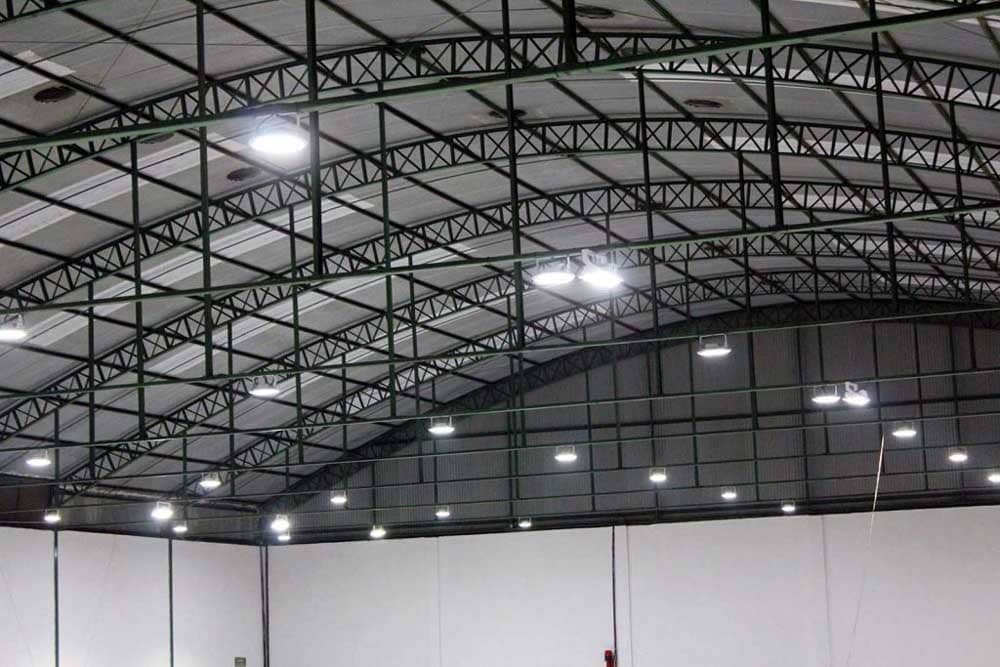
Industrial LED Lamp, Learn About Its Thermal Influence in Environments!
The thermal influence of industrial LED lamps is essential for businesses that want to achieve greater productivity and efficiency. After all, it contributes to better climate control in the environment, the visual comfort of employees, and other important points.
In this post, we will explain these relationships better. To start, lighting is an important factor in determining the thermal efficiency of an environment. In common sense, even laypeople know that some types of luminaires heat up the environment. This happens because part of the electrical energy in lamps is dissipated in the form of heat.
In addition, another factor that induces thermal sensation is the color temperature of the lamp. Although this is not directly related to the temperature measured by the thermometer, human senses are integrated. So, the color of the light emitted by the lamp controls the interpretation that our brain makes of the environment. Want to understand better? Follow along!
What is the thermal influence of lamps in the environment?
To understand this influence, it is necessary to know the physics behind the generation of light by electrical energy. The process is as follows: when an electrical current passes through certain materials, its electrons collide with the molecules and atoms of the lamp’s materials. As a result, energy is released in various forms, such as light and heat.
In this sense, every lamp will emit some amount of heat to some intensity. The big difference between different models is that there are materials and technologies that allow greater use of electrical energy to generate lighting instead of radiating heat.
To evaluate this, there is some very useful information on the luminaire box:
- Power – the amount of energy the lamp uses to perform its function (the higher the power, the more electrical energy will be consumed in a time interval);
- Lumens – the amount of light emitted by the equipment (the higher it is, the better the capacity to illuminate the environment);
- Luminous efficiency – the amount of lumens that each watt of power of a lamp can emit (the higher the luminous efficiency, the more light will be generated with less consumption of electrical energy).
In general, luminous efficiency is inversely proportional to the heating that the lamp generates in the environment. Why? Less efficient models lose a lot of energy in the form of heat. Therefore, they need more electrical energy to generate the same amount of light as a more efficient model.
What are the different types of lamps and their relationship with heat?
Next, we will explain the main types of lamps available on the Brazilian market.
Incandescent lamps
These are traditional lamps that have a transparent glass globe with a metal wire inside. When the electrical current passes, it comes into friction with the atoms of the metal, releasing light and heat. The temperature of this wire can be higher than that of the solar surface.
It is the most inefficient model of all and, for this reason, was rejected in all INMETRO energy efficiency tests. Because of it, many people associate lighting with heating the environment.
Fluorescent lamps
These lamps work differently because, instead of metal, there is gas inside. When the electrical current passes through it, light is emitted. Since it is about 4 times more efficient than incandescent lamps, heat production is much lower. However, there is intense heating inside its bulb.
On a residential scale, this is insignificant. However, when we are talking about industrial lamps that demand high luminous capacity, this heating can be intense. This harms the comfort of your employees, the efficiency of your air conditioning system, among so many other problems.
Industrial LED Luminaires
Finally, we have industrial LED luminaires, which are twice as efficient as fluorescent and 8 times more efficient than incandescent bulbs. Their great advantage is that energy production occurs through friction generated in small electrical circuits made of the same materials used in high-tech equipment: semiconductors.
With a small stimulus, the circuits of the industrial LED bulb can release a large amount of light. Consequently, there is minimal heat production. Almost all of the electrical current is used to achieve the purpose of the bulb.
SX Lighting is a leading manufacturer of industrial LED luminaires in Brazil, with units in Pindamonhangaba/SP and Manaus/AM. It has a structure of over 15,000 m² and one of the most complete professional lighting laboratories, with LED luminaires and floodlights with high energy efficiency, up to 180 lm/W, in its production. They are also ideal for industrial lighting with low energy consumption, also helping with thermal maintenance of the environment.
What are the advantages of industrial LED bulbs?
There are several advantages to using LED bulbs in terms of thermal influence in environments. In the case of industries, we will talk about two main advantages.
Greater energy efficiency
As we explained, industrial LED bulbs have the highest capacity to transform electrical energy into light. With 1 watt of its power, we can produce the same amount of light as 2 watts of fluorescent bulbs and 8 watts of incandescent bulbs.
In other words, in terms of energy consumption, there is significant savings. On an industrial scale, very strong lighting is usually required to allow for proper execution of work. Thus, systems with more than 20 high-power bulbs are needed.
For example, industrial LED reflectors use a power of 30W to 250W. The equivalent of incandescent bulbs would be from 240W to 2000W, while fluorescent bulbs would be from 60W to 500W. Thus, the cost of inefficient lighting would reach hundreds or thousands of reais every month.
Greater luminous comfort
In addition, industrial LED luminaires can be manufactured to emit various color temperatures. Have you ever noticed that each lamp emits a different colored light, which can be very white or yellowish? This is not related to heat emission, but to the property of the light that comes out of the lamp.
The closer to yellow, the warmer the color temperature is said to be. On the other hand, intense white or bluish colors are known as cooler tones. However, we emphasize that there is no significant difference in heating due to the color temperature. As we explained, this point is mainly related to energy inefficiency.
However, the human brain integrates all senses to interpret the environment. Thus, some people may have the subjective sensation that warmer tones heat up more. LED luminaires are versatile in this sense, as they can be manufactured to emit various tones of color, from warm to cool.
Choosing an industrial LED luminaire means having a much more complete and efficient product, reducing the thermal influence of the lamp in the environment. In addition to reducing costs related to the energy consumption of the lamp itself, it reduces the need for air conditioning. After all, it will be one less equipment emitting high amounts of heat into the environment.
Now that you are convinced that SX Lighting will provide you with the best industrial lighting, click here and request assistance from our specialists.
Share







